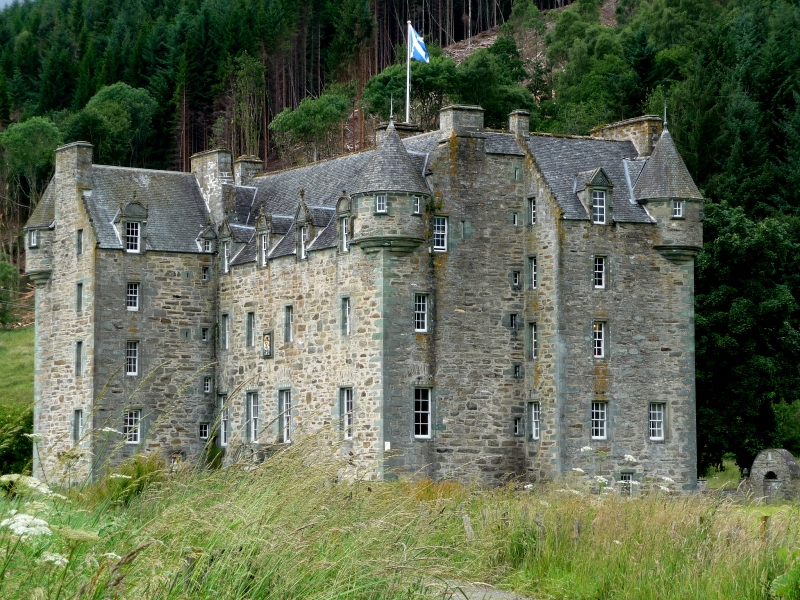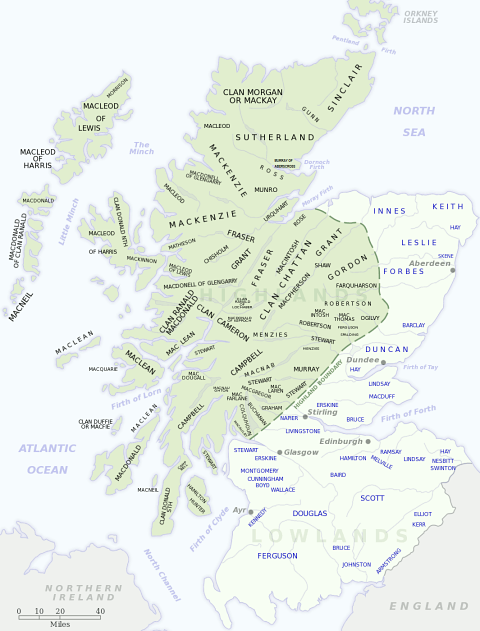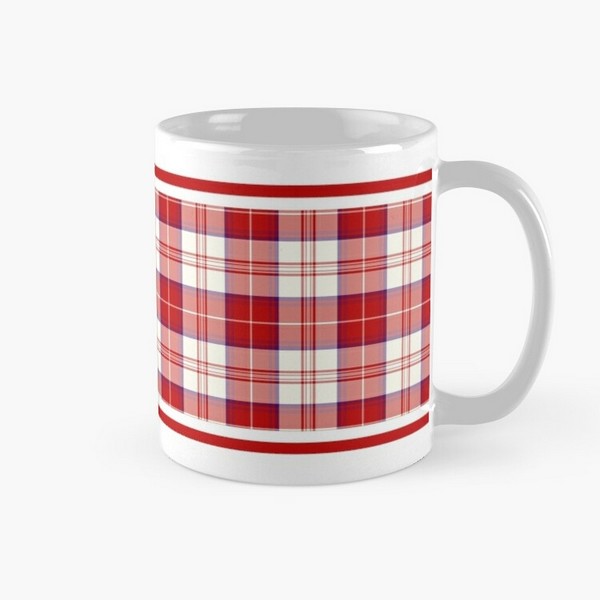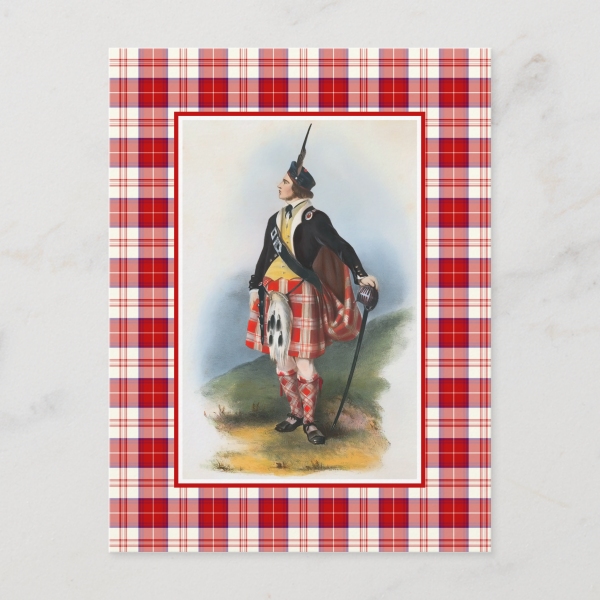
Motto: God willing I shall
Historic Seat: Castle Menzies
District: Perthshire
Associated Surnames: MacIndeor, MacMenzies, MacMinn, MacMonies, Means, Murchie, Murchison, Mein, Meine, Menie, Meyners, Minn, Minnus, Monzie
Associated Tartans:
Early Menzies Genealogy and History:
(Excerpt from "The Scottish Clans and Their Tartans", James Grant, 1906)
The chiefs of this clan are not of original Celtic descent, though the clan itself is descended from a Gaelic-speaking race, according to Robertson. The name Menzies, or Mengues (as it was originally spelt), was among the first names, according to Scottish antiquaries, adopted in Scotland in the reign of Malcolm III, when these designations were introduced into the kingdom.
In the time of Robert I (1306-30), Alexander Menzies resigned the lands of Dorisdeir, in Nithsdale, which the victor of Bannockburn1 granted to James, brother of Walter, the Lord High Steward. The same King granted charters to Thomas Menzies, Knight, of the lands of Unwyn (Oyne?), in the Garioch, and other lands of Fothergill, in Atholl. Also two charters to Alexander Menzies of the Barony of Glendochyre, and the darach2 land of Finlargis (Finlarig?)
David II (1330-70) granted a charter to Richard Menzies of an annual, furth of Newabie,3 in the shire of Peebles; and in his reign William Menzies was Keeper of the Royal Forest of Alythe, in Kincardineshire. In the same reign Robert, son of Duncan, Earl of Atholl, granted a charter to Alexander Menzies of Fothergill, "upon the marriage of Jean, daughter to said Robert, one of the heirs of Glenesk." King David granted a charter to Robert Menzies, Knight, of the Barony of Enache, which Robert's father had resigned to Robert, the Great Steward, for a new infeftment.4
Sir Robert of Mengues, Knight, who inherited the estates of his father, John de Mengues, in 1487, obtained from the Crown, in consequence of the destruction of his mansion house by fire, a grant of the whole of his lands and estate, erected into a free barony under the title of the Barony of Menzies. From him the Baronets of that name are lineally descended.
In 1586 we find "Barbara Stewart, Ladye Weyme, relict of Umquhile James Menzies of that Ilk," binding herself to be faithful to George, Earl of Huntlie, during the ward and nonentry of her son Alexander, signed at Menzies, in presence of Menzies of Snype, Patrick, son of Menzies of Morinche, and others of the clan (Gordon Papers, Spald. Club.)
A year or two before this time we find two of the gentlemen of the King's Guard, Menzies of Quhite Kirk and Menzies of Culterhallis, for themselves and others on the muster roll, prosecuting the Earl of Montrose, Collector-General, for failing to make them proper payments for their services.
In 1633 another gentleman of the clan, Robert Menzies of Kinmundie, Provost of Aberdeen, was knighted at Holyrood by Charles I, after his coronation. The Provost was also Commissioner for the City in the Parliament of that year.
In 1650 and 1651 a Lieutenant-Colonel Menzies, who captured the Marquis of Huntly, was Commissioner of Fines; and though in the service of the Estates, he was accused of obstructing the levy of troops in the Isles, and so plundering the lands of Seaforth, that the Earl was unable to march his regiment from Kintail. Various branches of the clan appear in the Parliamentary Acts of Charles II, among them the Lairds of Castlehill, Combrie, Enoch, Pitfoddels, and others.
In 1738 Menzies of Culdares brought in his portmanteau from the Tyrol seven little saplings of the first larches ever seen in Scotland, which he planted in that year, and two, that are now in the Dunkeld grounds of the Duke of Atholl, are the most gigantic specimens of the kind in the country.
In the 1745 the Lord President estimated the fighting force of the clan, whose chief, he says, is called in Gaelic Menairich, at 300 men; but they were not "out" with the Prince, though Colonel Menzies of Shian was, and had a small regiment under his standard.
An old branch of the clan were the Menzies of Pitfoddels. Thomas Menzies of Pitfoddels was Provost of Aberdeen in 1551, and held that office till his decease in 1576, and was succeeded by his son, Gilbert of Pitfoddels, which he also held till his decease in 1588, and was succeeded in office by Thomas Menzies of Durne (Spald. Club, iii.). In the wars of Montrose the then Laird of Pitfoddels adhered to him and the King's cause with steady loyalty and great valour. At the battle of Invercarron, where the Marquis was finally defeated in 1650, "young Menzies of Pitfoddels, who carried the Royal Standard, with Major Guthry, were killed close by him" ("Hist. of the Troubles," folio). This line became extinct about forty years ago.
Alexander Menzies, of Castle Menzies and that Ilk, son of Duncan (by Jean Leslie, only daughter of the Master of Rothes), was created a Baronet of Nova Scotia in 1665. He married Agnes, daughter of Sir John Campbell of Glenorchy (father of the first Earl of Breadalbane), by whom he had a son, Robert, who predeceased him; but by his wife, Anna, daughter of Walter Lord Torphichen, he left a daughter married to Menzies of Cultrallers, and Alexander, who became the second Baronet of that Ilk. He married his cousin, Christian, daughter of Lord Neil Campbell, and had (with a daughter married to MacIntosh of that Ilk), a son, Robert, who became third Baronet; and as the family is still in existence, his descendants are to be found traced in any Baronetage.
(End excerpt)
Next page: Clan Munro
Footnotes:
1 The Battle of Bannockburn (1314): The Battle of Bannockburn was fought on 23 and 24 June 1314, was a victory of the army of Robert the Bruce, King of Scots, over the army of King Edward II of England in the First War of Scottish Independence. Read more about the Battle of Bannockburn at Wikipedia.
2 darach: oak
3 furth of Newabie: Outside the village of Newbie in Peeblesshire, possibly Newlands in present-day Scottish Borders council area.
4 infeftment: the official or symbolic bestowal of heritable land on a person

Distribution of Scottish clans and families
View larger map at Wikimedia Commons

Browse the Clan Menzies Tartan Collection with clothing, home decor, accessories, electronics cases, and more.

Browse the Culloden Blue Dress Tartan Collection with clothing, home decor, accessories, electronics cases, and more.

Clan Menzies Postcard: Digitally cleaned and enhanced vintage illustration with tartan border.